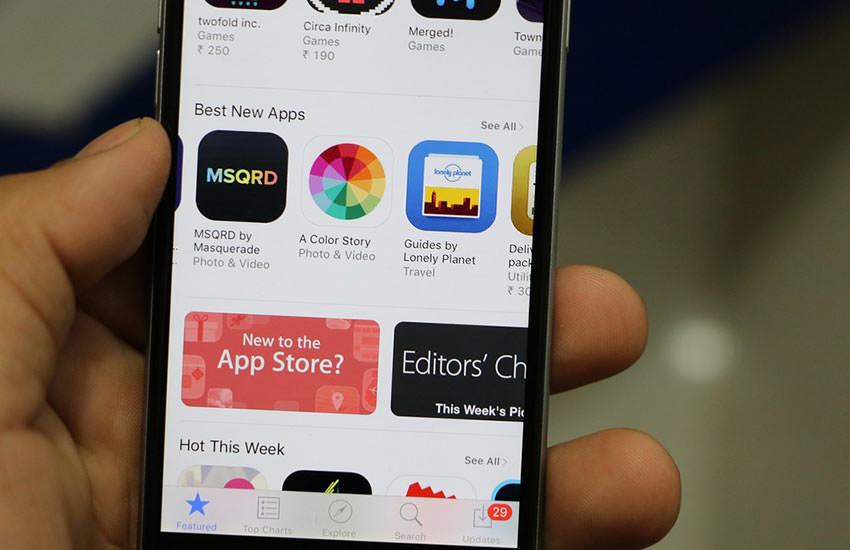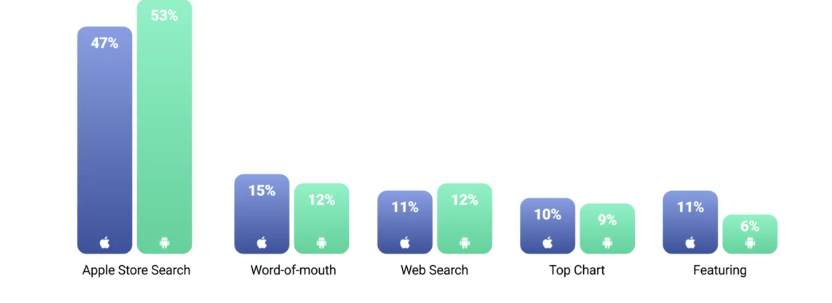10 Best Practices for App Store Optimization?

Sometimes, app creators feel worried because only a few apps succeed. But here’s the best part: you can be one of the extraordinary 0.5% who succeed.
A lot of apps fail because people don’t see them. They need to reach the right users.
So what’s the solution? It’s App Store Optimization(ASO).
ASO is like giving your app extraordinary power. By changing a few essential things on your app’s page, you can ensure more people see it.
Suppose your app is a bright light in a big forest of apps. ASO helps your light shine even brighter so the right people notice it.
We’re here to assist you with ASO. Here you’ll comprehend how to make your app stand out and get seen by the people who need it. It’s like a magical spell that brings more attention to your app in the app store. Let’s discover the magic of ASO!
1. Compelling App Title and Icon:
Creating an appealing app title, like a catchy name, is one of the app store optimization best practices because it’s the first thing people see when they search for apps. It’s a big deal for ranking well on app stores like Apple’s and Google’s.
You only have 30 characters to work with, so you need to be clever with your choices. It’s good to use words that show what your app does but keep it simple. Your app’s name should sound natural, easy to remember, and include crucial words. Like, if your app is about making invoices, you could use “invoice maker” in the title, along with other related terms like “simple” and “easy.”
But don’t just settle on one name. You’ll need to try different names, keywords, and combinations to find out which brings in the most downloads for your app.
2. Keyword Research and Optimization:
Within the Apple App Store, there’s a dedicated spot where you can insert keywords. This app store keywords best practices can help your app appear higher in search results. So, optimizing your keywords is essential to make your app more visible. This is especially true because most people find new apps by searching for them.

Image source:- splitmetrics.com
You can add as many keywords as you want, but you’re limited to 100 characters. Remember, commas (without spaces) are used to separate different keywords. Like with your app’s name, this is your chance to get creative with your chosen words.
This keyword space is also your testing ground. You can experiment with various keywords and combinations to determine what works best for your app. It’s an intelligent strategy to balance between popular keywords with a lot of competition (so you might not rank very high) and less common keywords that can get you downloads because there’s less competition.
Here’s an important tip, Apple indexes these keywords uniquely. So, avoid repeating the exact words or phrases, even if they’re part of your keyword research. For instance, if you’re thinking of “invoice generator” and “invoice maker,” you wouldn’t include both. Instead, you’d eliminate the repetition and use “invoice generator, maker.”
3. Clear and Concise App Description:
Your app’s description is crucial to your App Store Optimization (ASO) strategy. It’s a space to explain your app and its features freely. Google Play has a short (80 characters) and a long description (4,000 characters), impacting rankings. Apple’s App Store uses only a long description (4,000 characters), which doesn’t affect rankings directly. However, descriptions still shape how users see your app, impacting downloads that affect rankings.
Creating an appealing description is critical. Clearly state your app’s purpose, highlight its features, and show how it solves problems. Use keywords from your research to boost your ranking. Even if not for order, keywords tell users they’ve found the right app.
Take time to write an engaging description. It helps users understand your app better, leading to more downloads and indirectly affecting your ranking. Remember, a well-crafted description can connect your app with interested users effectively.
4. High-Quality Screenshots and Videos:
Adding a video to your app’s page can lead to a whopping 35% increase in downloads, which is a big jump. This boost is even more significant than improving your app’s title (which can bring a 15% increase) or enhancing the visuals (which can give you a 30% increase). What’s remarkable is that more downloads also mean your app climbs higher in the rankings, making it more visible to others.
Think about how we usually want things quickly, like finding and downloading an app in just a few minutes. That’s where one of the best app store best practices of inserting a video comes in. When you make a video showing off the best thing your app can do, it’s like a sneak peek immediately catching people’s attention. This quick connection can lead to more people downloading your app, boosting the rankings.
So, by using a video to show what makes your app awesome, you’re not just getting more downloads; you’re also giving your app a better chance to shine and become more popular.
5. App Ratings and Reviews:
User reviews are among the best app store optimization best practices that boost your app’s visibility and success. Gathering more thoughts can significantly enhance your App Store Optimization (ASO).
Human behavior shows that when people see others praising a product, they’re intrigued to try it themselves. From a technical perspective, app store algorithms consider reviews and ratings when ranking apps. So, the more reviews you collect, your app will rank in search results.
This was seen when the app Layout from Instagram launched in 2015 and gained immense popularity.
To gather positive reviews, you can ask your users. However, the timing matters – it’s best to ask after they’ve used your app for a reasonable time or completed a task. This is when their satisfaction is likely to be highest.
6. Nail Your Categories
Choosing the correct category for your app might not seem like a big deal, but it significantly impacts how many people find and download it. Two important things to consider are how well the category fits your app and how many others are in that category.
Picking the right category helps your app show up for people interested in what it does. For example, if your app allows people with diets, putting it in the Health and Fitness category is brilliant because people looking to lose weight often look there.
Another thing to consider is how many other apps are in the same category. Sometimes your app could fit into more than one category. For example, a diet app could also fit the Food and Drinks category. But if you have a choice, picking the sort with fewer apps is usually better. That’s because your app has a better chance of being noticed in a less crowded category. The popular categories have a lot of big apps with big budgets, so it takes more work to stand out there.
7. Localize for Different Markets
The app stores count a lot of different apps on the general level. However, the stores in various countries are localized and rely on the local language. Some need to perform localization, which is a huge mistake, as you miss out on huge markets with millions of potential customers.
For the first run, relying on Google Translate will do the job for simple sentences in the description. Still, if you notice a surge of downloads in a specific country, you can easily hire a translator to perfect your explanation for that language. When it comes to the app itself, use this one of the best app store best practices, that are localizing, as there is little text throughout the. Doing this will open your app to millions of other users, bringing incredible results.
8. Monitor Competitors
Keep an eye on your competitors by examining their apps closely. This helps you pinpoint their strengths and weaknesses. Doing so gives you valuable insights that can guide your app’s development and marketing strategies. Learning from your competitors is brilliant, allowing you to stand out by emphasizing your app’s distinct value.
When you assess your competitors, focus on what they do well and what they struggle with. Understanding their successes and failures can inform your decisions. For instance, if you notice a competitor excelling in user engagement, you might adopt similar techniques. Conversely, if you find gaps in their offerings, you could tailor your app to fill those voids.
Your app’s unique selling points are what make it special. As you delve into your competitors’ landscape, aim to differentiate your app by amplifying its unique features. You aim to present users with something that sets your app apart and fulfills their needs better.
9. Make A/B Testing a rule
Carrying out A/B testing should be a norm to explore diverse variations of your app’s metadata, including the title, description, and screenshots. A/B testing involves comparing these different versions to identify which components yield improved conversion rates.
This technique is an invaluable tool for gaining insights into user preferences. By systematically changing specific elements and analyzing user interactions, you can pinpoint the factors that contribute most to attracting and encouraging users to take action, such as downloading your app.
A/B testing allows you to make informed decisions based on data rather than guesswork. It empowers you to optimize your app’s presentation, refining its messaging and visuals to maximize its effectiveness. This iterative process enables you to enhance your app’s appeal continuously, ultimately leading to higher conversion rates and a more successful app.
10. Promote Outside the App Store
Extend your promotional efforts beyond the confines of the app store by leveraging a multifaceted approach. Harness the power of social media, content marketing, influencer collaborations, and various promotional avenues to steer traffic toward your app store page, amplifying downloads.
Diversifying your promotional channels by knowing all the latest trends in mobile app development enhances your app’s visibility, enabling it to reach a broader audience. Through the strategic use of social media platforms, you can engage potential users, offering insights into your app’s value and functionality. Content marketing further solidifies your app’s presence by crafting informative and appealing content that resonates with your target audience.
Next, partnering with influencers provides an authentic and impactful way to showcase your app to their dedicated followers. Their endorsement can instill trust and curiosity, potentially translating into higher downloads. Similarly, you can avail assistance of a professional mobile application development company who can offer some viable suggestions to promote your app against changing circumstances.
The Final Verdict
These are some of the most critical app store optimization best practices that you have to follow if you want to optimize your app for all markets. Be different from the competition, attract attention, and intelligently utilize keywords. Don’t forget to add screenshots for both phones and tablets, as the tablet market is increasing fast, counting millions of new users on the app store.
Finoit is a leading mobile app development company, providing quality web , IoT, android and iPhone app development services.
For the last one decade, we have developed over 450 mobile apps and have assisted many solopreneurs in their journey of startups by functioning as a tech partner and rolling out their product ideas. For questions/queries, you may write to us at info@finoit.com

